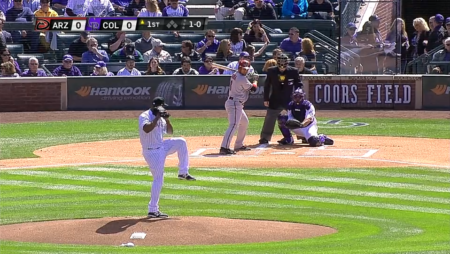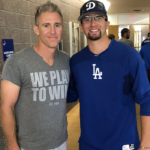MLB Games Telecast from Center Field, with Love
 The Baseball Telecast
The Baseball Telecast
It’s tough to watch a baseball telecast. Not tough to be a baseball fan. But tough to watch every game exactly the same way from the same vantage point. It’s as if every game is played in the same stadium and the game starts with the same baseball prelude: a brief ditty that begins, from center field, with love. And then continues the next three hours. From center field. With love.
The irony is there is no regulation baseball stadium. Once you get past the infields, which are standardized—90 feet between the bases and 60 feet, six inches from the pitching rubber to home plate, and behind it, to second base—baseball outfields are different dimensions and angles. Just as baseball is the only sport without a regulation playing field, it’s also the only game where the camera angle remains the same most of the game.
This telecast view is the brand of baseball and it’s consistent, like McDonald’s famous yellow arches. Easily recognizable. Show the action at home plate and only the uninitiated won’t know they’re watching a Major League Baseball game. It’s a very well-known scene, and for long stretches, the camera does not move off the quartet of pitcher, catcher, batter and umpire, even though there are seven other defenders on the field.
No wonder the games can become boring. They’re visually limited. No matter the stadium. Add to that, baseball telecasts minimize field differences, yet these differences are integral to the way the games are played and the lineups each manager submits to the umpire before every game.
There’s a reason why the New York Yankees have been a predominantly left-handed hitting team for many years, just as the Boston Red Sox have been a primarily right-handed hitting team because of the Green Monster. Long-time fans know the differences. But do the newer, younger fans?
On baseball telecasts every viewer sees the game from center field. No matter which stadium the game is being played in. This is the view of the game. The one certainty is that center field is center field in every stadium. Anywhere from 380 to 400 feet from home plate. The other certainty is that this look is the brand of baseball telecast every game over the six months of the season between March and September.
In many ways, the only real difference between the game on a black and white television in the 1960s and the game shown today is the amazing clarity of the HDTV color picture. The frame of the game is the same.
The thing is, there’s more than one way to see baseball telecast. Especially in this technologically sophisticated era. Superfast computers. Lightning fast network connections. Interconnected databases. Artificial intelligence interfaces. All of which could blend together to create a mélange of related information that could, if reimagined, foster a new style of baseball game on television.
For example, using AI-based voice systems to respond to user requests, telecasts could hook into databases of text, graphics, and audio materials that could easily be produced on-demand.
Among baseball teams this explosion of statistical data is called analytics. Sabermetrics. Well-documented in the press, this data has taken the baseball world by storm, and created uncertainty. Just what is the right way to manage a team? Position a defense? The right way to secure players? Every team seems to have their own thoughts on the matter.
I don’t play baseball video games, but the interface on those games are more along the lines of what baseball on television could copy. There’s a view of the game itself, and that view differs by game and stadium. Then there are associated shots and data on other clickable panels on the side of the screen. Perhaps a choice of relevant analytics. Or what about panels with historical asides about the stadium or the team? Even links to team blogs or other related baseball websites. On a screen like that, there would be a lot more to be excited about as the game is played.
But right now, baseball is struggling to figure out how to best tell its fans it’s not the same game it was when Babe Ruth was swatting blasts out of the House that Ruth Built. Or the same game that Branch Rickey revolutionized with his brilliant creativity. Or even the same game that Marvin Miller overturned so completely when he freed players from the Reserve Clause in the early 1970s.
Nope—Baseball’s Changed
Starting pitchers don’t complete games. Closers are no longer necessarily closing games. Hitters strike out with alarming regularity. And, alas, catchers can’t seem to reliably catch pitches anymore. Only the center field camera seems a sure thing as it unabashedly captures this mayhem.
MLB baseball seems intent on pasting new changes on top of the game, which is what the dreaded pitch clock would be. A new imposition. Just as the intentional base on balls was eliminated from the game. Some of us miss that brief action.
The pitch clock will force pitchers to throw the next pitch within 15 seconds, otherwise umpires will be allowed to add a ball to the pitch count. But will this shorten games? And if it does chop 15 minutes off a game, will that make games more exciting?
Rather than change the game of baseball, MLB should think about how baseball is telecast. It’s easier to change the telecast than the game.
What about multiple camera angles? Or side panels of data? Or layers of data on the game, the batter and the pitcher? Perhaps fans could even purchase subscriptions to data sources or other services, and see data on-demand on their screens as the action unfolds. Or ask questions of the system employing an AI interface. Perhaps a fantasy baseball broadcast on a sister channel also makes sense.
The point here is rather than change the basic character of baseball, MLB should begin to more aggressively define the telecast.
Forget time clocks.
Rather, institute new rules requiring a managers to bring in relief pitchers for a minimum of three outs per appearance. That would speed the game up, not to mention force GMs to acquire pitchers who are not merely righty or lefty specialists. This sort of organic change would put a limit on endless pitching changes that waste a lot of time.
Other ways to Shorten the Game
Broadcasts of European football feature no commercial breaks during the action. Instead they routinely show graphic ads, scrolling ads at the top of the screen, and placeholders during games. Some telecasts even leave a sponsor name on the screen for a minute (or longer) while the game is played. These ads that do not detract from the action and bring in revenue. In fact, many ads are transparent.
Whereas the short 15 second ads during the last World Series were intrusive, especially running as they did in between pitches. They interrupted the flow of the inning. A silent banner at the top of the screen would have been more efficient. Worse, because many of the ads were the same, and shown over and over, they detracted from the broadcast.
Baseball is now in the 21st century, isn’t it time MLB telecasts reflect this fact?

























